The United States Military is not known for being touchy-feely. There’s not much hugging or head-patting, and superiors don’t always have the authority to offer a serviceman a raise or promotion.
When a member of the Army, Navy, Air Force, Marine Corps, or Coast Guard wants to show appreciation, love, sympathy, or professional connection, they can use challenge coins.
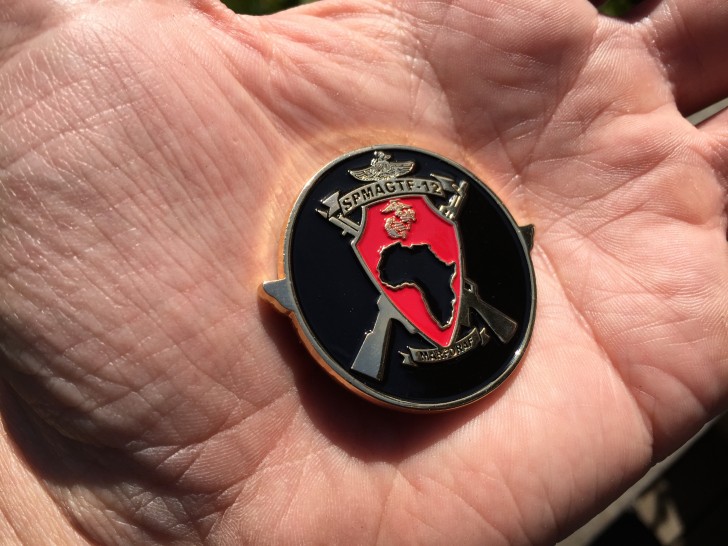
Challenge coins are not currency. Different branches of the military have different uses and customs for them, but when they’re being given or exchanged, the coins serve as literal tokens of gratitude. They can symbolize everything from a nod of appreciation to a deep personal connection.
Challenge coins don’t exactly look like regular coins. First of all, they’re usually pretty large– about two inches in diameter– and they can be in any shape and color imaginable. They can look like a ninja star, or a crown, or a ship, and be covered in glitter or glow-in-the-dark paint. Some have centers that can spin or have a built in bottle opener.

Within the military, coins are exchanged with a traditional handshake. The coin-giver places the coin in their palm and reached out to shake the hand of the coin-recipient. Then, hand grasped, they turn their handshake over so that the coin falls from one palm to the other.
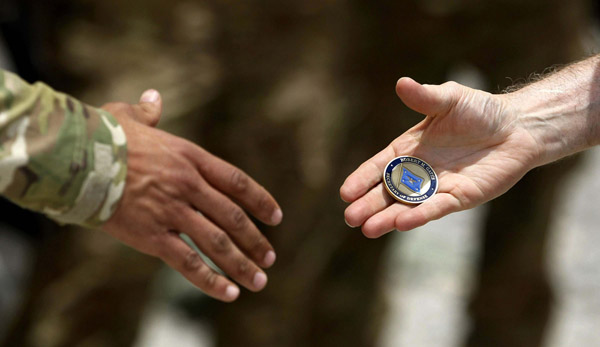
The handshake is not necessarily standard practice, since coins are also given out occasionally to civilians. For that reason, you end up finding coins in places where you would not expect to find a connection to the military, such as in the hands of anti-war academics or journalists. When these coins get given out, they are a physical reminder of the fact that the military is not some faceless monolithic structure. The coins show that the military is an organization made of human beings.
Those bottle opener challenge coins could come in handy, because challenge coins are often used to play a drinking game. Different branches of the military have different rules for the game, but the gist of it is this: you can throw down your coin, and perhaps holler out “coin check!”; everyone else in the group must pull out their challenge coins, and whoever doesn’t have one buys a round of drinks.
But—if everyone has their coin on them, the person who initiated the coin check is liable for the tab.
Not all of the branches of the military are into the drinking game, but those who play are in it to win it. Some have their coin on them at all times, even when they’re sleeping, running, or showering. You just never know when you could get checked.
As far as the history of challenge coins goes, there’s a sort of apocryphal story that traces them back to World War I. According to the story, an American army officer had some special coins minted for his men on whim. Later one of these men was captured by French soldiers and he used his coin to prove he was an American and not a German. But that’s just one version of the origin story.
However they came about, the coins have always been about identity. Each unit designs their coin to tell a story about how they want to be perceived. Since identity in the military has a lot to do with hierarchy, there is also a hierarchy with challenge coins. As you move up through the ranks, challenge coins become more essentially valuable because they’re harder to get. It’s difficult to get a Chief of Naval Operations coin. It’s exceptionally rare to find a presidential coin—but they do exist.
The president’s coin is the rarest there is. This is a video of Obama giving his coin to a woman who lost her brother in Afghanistan:
The military isn’t the only institution to use challenge coins, although they were the first. Now some police and fire departments make coins, along with NASA, sports teams, and even performers and musicians who tend to perform for soldiers on USO tours.
Really anyone can design a coin and then just go online and order it. That’s basically what the military does, since these coins are manufactured with by private mints with private funds.
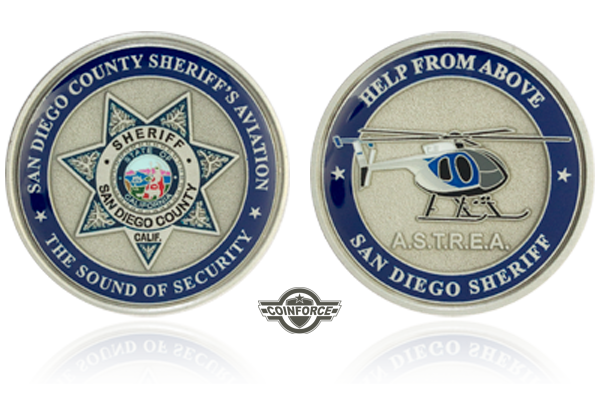
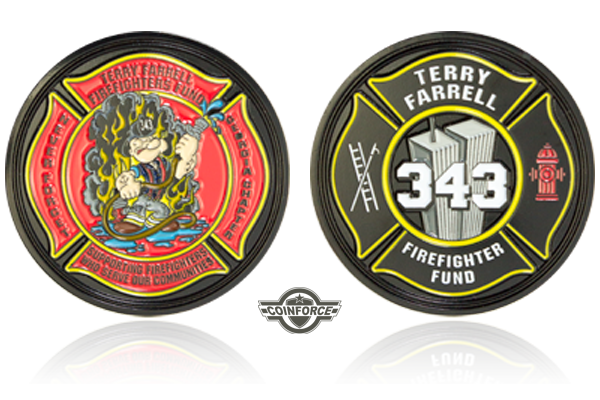
Because the coins are not in any sort of budget, there’s no set procedure or rules for making them. This means the design process is very informal. Usually, after a unit raises the fund to order some coins, they find a design by just sitting down and talking about what they want on their coin.
Then someone in the group will make a sketch or a rough mock-up, which they then send to the manufacturer.

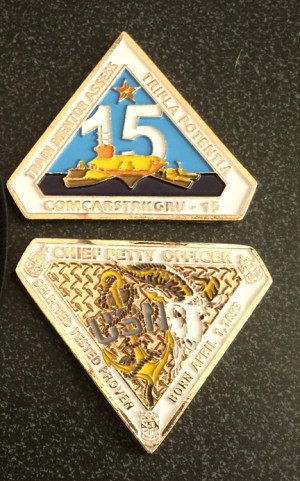
The individual coins take on a whole new meaning when a whole collection is displayed together.
A lot of active and former military members have displays (or even build custom furniture) to show off the coins they’ve acquired over the years.
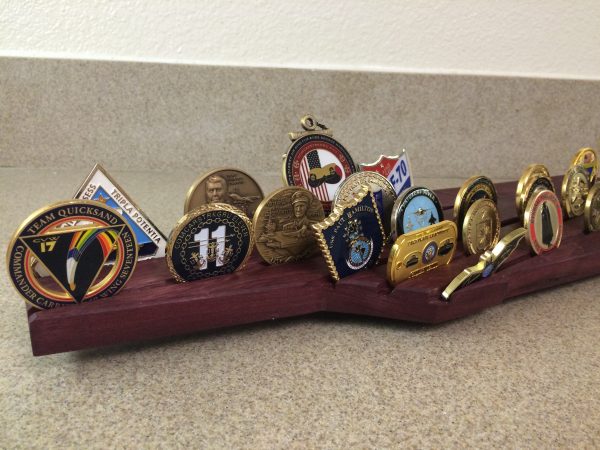
Actually, in Bill Clinton’s presidential portrait, he’s posing in front of his collection of challenge coins.
But these coins displays are not a flashy show of achievement. Quite the opposite. The coins are physical proof of hard fought relationships.
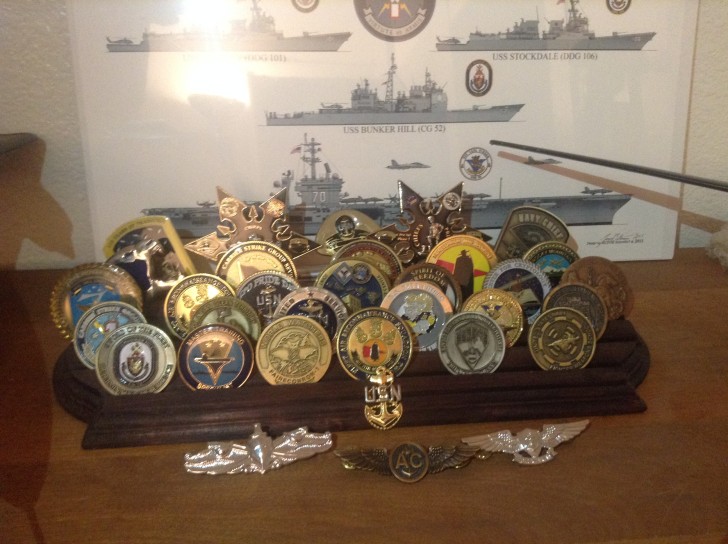
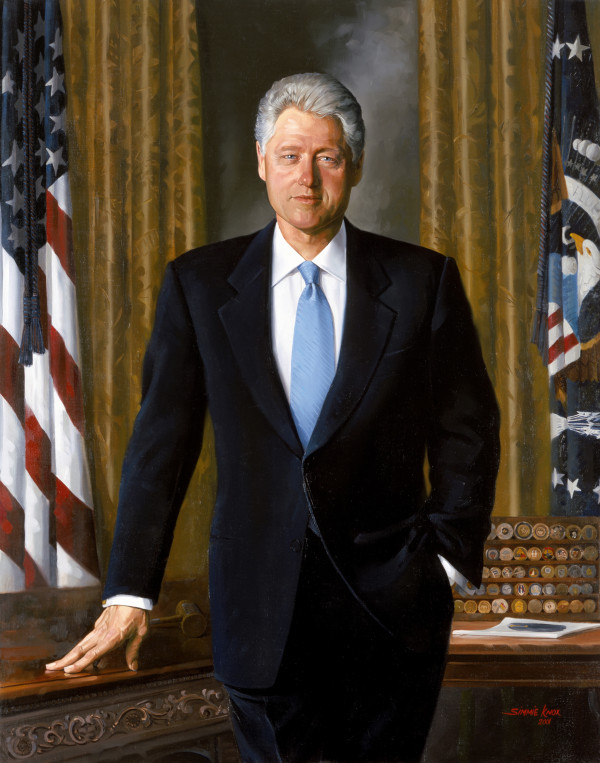



Comments (32)
Share
Where is the download link?
My apologies- found- but fyi not presently available on default mobile site.
My coin from the office of the air surgeon
http://www.imgur.com/H81O73e.jpeg
Challenge coins have also been adopted by foreign militaries as well. My most cherished coin was given to me by the Japanese Self Defense Force (Army) Sergeant Major who gave it to me as a sign of appreciation for professionalism.
I came across a tradition that may be the basis of the exchange of coins… “Tokens of Hospitium” were used in ancient Rome as a promise of reciprocal hospitality.
I encountered this in the novel “SPQR: The King’s Gambit” by John Maddox Roberts (the end of chapter 5, if you want to see more details about the tradition).
Got mine personally from the CO when I made First Class Petty Officer.
Mental Floss did a pretty good story on the history of Challenge Coins that’s worth checking out:
http://mentalfloss.com/article/12630/brief-history-challenge-coins
I admit I had no idea this was a thing. But it did remind me of a similar tradition with the Catholic culture. I’ve been given big hefty coins like these with images of saints or other catholic iconography. I really have no idea what to do with these other than store them away. One coin is a beautiful heavy coin with a bust of St Dominic Savio.
I have four of them. What I find interesting is that every commanding officer has their own rules for handing them out. One of my coins was for helping out with the office picnic at my old agency, and while I appreciated it I find that to be a rather low bar. Other commanding officers, you pretty much have to save somebody’s life before you’ll get a coin.
One minor correction to this story. Before the recent budget tightening, Battalion level and above commanders were afforded a budget to purchase coins.
I’ve designed 4 different coins over my career. As a tank company commander I paid out of pocket to construct a coin for my unit. As a cavalry squadron commander I had a unit coin and a deployment coin both paid for out of appropriate budget. And finally (and currently) I got my coin designed and paid for prior to the Secretary of the Army’s prohibition of using budget for the coins.
I’ve found soldiers value a unit coin more so than a standard Army award. Another ribbon is just that, another ribbon. But a coin is a meaningful representation of the unit and their relationship to it. As such I usually have a slightly higher bar for giving them out. It doesn’t mean much if you give them out to anyone for any small thing.
That said, as a captain I once received a coin for ‘getting out of bed.’ While deployed at the National Training Center (Fort Irwin CA) a concerned major wanted to make sure his materials (in the form of several 40 foot MILVANs tractor trailer loads) were scheduled for return back to Fort Hood TX. He came in about 2 am and my soldiers awoke me and the lieutenant who worked for me. We resolved his worries in a matter of minutes standing barefoot and bare chested in a cold, dark warehouse. As he left he gave us both coins. I protested that “we were just doing our job.” His reply was “well some people wouldn’t have gotten up to help me.”
Every coin I have (somewhere around 90+ over a 25+ year career) has a story like that. That’s why they are valuable.
I got a coin from the director of DFAS. I knew they were tokens of appreciation but had no idea there was such a rich tradition surrounding them.
As usual, the Terminal Lance comic strip has done a great job of summarizing my experience.
http://terminallance.com/2010/04/06/terminal-lance-27-challenge-coins-not-a-grunt-thing/
Thank you so much for talking about this! I have about 30 challenge coins, some from other branches and even a few from other country’s Air Forces. As the podcast said, they are an amazing mixture of thanks, brotherhood, and pride. Few people outside of that lifestyle know about them, and I’m glad you exposed this unique tradition.
My daughters do not know it yet, but there are two Air Force Brat coins waiting for them when they get old enough to understand what they are :-)
Neat story. I heard from a friend about it as used by bartenders. I suspect it’s spilled out to other professions as well.
I have had the privilege to meet dignitaries as a driver in the Indianapolis 500 Festival Parade. Three times that dignitary has been a member of the military. Having never heard of these coins, I was stunned the first time one was handed to me. It’s nice to think of the people behind them when I look at them now. The enthusiasm and kindness of Gen. Pete Chiarelli, then Vice Chief of Staff, US Army, the formal bearing of the Adjutant General of the Indiana National Guard and a plastic-encased coin from a high-ranking officer in the Slovenian Army! Great memories.
I recently saw a challenge coin on Jimmy Fallon given to him by the Chief of Naval Reserve. You can see the image at http://embleholics.com/united-states-navy-reserve-100-years-jimmy-fallon/
Anyone know where the download link on the mobile site has gone?
Huh. These remind me a lot of sobriety coins in AA, which are given to people at the anniversary of their sobriety by other group members, especially during the early 30, 60 and 90 day mark.
I’ve attended men’s retreats at a prior church where a challenge coin was given to the person who most contributed to the success of the retreat. The tradition was started by a church member from the air force.
Great piece!
Bartenders, particularly here in the Bay, love us a shot of Fernet-Branca. And a lot of us carry F-B challenge coins. https://instagram.com/p/vxiCa5vxJG/
Do we play drinking games with them? Hell yeah, we do! https://instagram.com/p/ylp8ilvxKh/
Lots of military men and woman make their own custom challenge coins. They are unique in that they represent the units and organizations that they make them for. You can check out some coins that we have made on our site http://www.embleholics.com and see what others have created for their own military organization. Great article!
Data point, or maybe ‘anecdote’. I served in the Marines from 1985 to 1993, as an 0311 and then 4063.
I never, ever, heard of anything like a challenge coin.
So it’s either a new thing since then, or a thing that wasn’t done for a while during the Cold War.
It started in the Air Force and over my 23 years I watched it spread. I’m sure it has to do with the fact that the branches have increasingly grown more comfortable working together in the many joint actions. I joined in 1994 and got my first one at basic training graduation, handed over in the handshake talked about in the podcast as part of the obligatory “Shake Take and Salute.”
I have a Challenge coin that was given to me by President Bill Clinton…(Y)
I had new student orientation at the University of Lethbridge here in Lethbridge, Alberta, Canada today and we were given a challenge coin at our commencement ceremony. I don’t know if it’s a new tradition or not, they didn’t say, but I was so excited! I immediately remembered this episode and was thrilled to know what these coins were. Most of the people I spoke to didn’t know, but were interested in using them. I am excited to see how this tradition grows at this university and in the scholastic world in general!
I made mine at and my church is making some, too. I have collected 9 over the years.
Sorry, I mean I made mine at noblemedals.
As a civilian within the DOD, I have a couple challenge coins presented to me. They are very meaningful to those of us who have the opportunity to be awarded them.
Had some challenge coins made by the guys at http://www.embleholics.com They are veteran owned and operated and give back to veteran non-profits. A great group of guys and made some amazing coins. Also their customer support is on it!
I was given a challenge coin by the security department of Disneyland when I worked there. Many of the security Cast Members (employees) are veterans so after reading this, I’m not surprised that they carry and give out coins as signs of appreciation as well.
Can anyone enlighten me a little about challenge coins. I’ve listened to episode 156 today, which explains what they are but I feel like I’m missing a key point.
What happens when a person gives away their coin? Do they simply have more so can give another away at a later date? Or do they only get one and once its gone they need to produce a new one?
It seems as though you don’t give away a coin that you have recieved, but then what do you carry around for a coin check if not the one you give to people?
We used to do a ‘pfennig check’ in bars in Germany in the 1980’s. I recall the locals playing along, but that might have been due to American influence more than German tradition. I still have my pfennig for luck, and many military coins for work as a civilian for military members. I have a White House coin from the Commander of the WH Management Office.